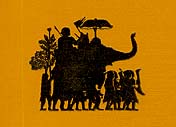

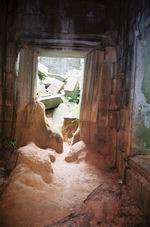
Photographs by Willard Van De Bogart
Click on all images for larger views
Ke, my Cambodian guide, slowly led me down one fallen wall of stones and up another. If I didn't know I was in Beng Mealea I might think I was just climbing over a huge pile of stones.
 Click on image for larger view
Click on image for larger view
But every now and then figures appeared on the stones and remnants of human design catapulted me into a mysterious realm of dark shadows and vine covered walls.
I was forever vigilant for fearing I may slip and fall as I began to climb down the side of a gallery wall. When I arrived at the bottom, a very small entrance appeared between two pillars that had almost been concealed by the fallen temple stones. It turned out to be an entrance to a long submerged gallery that had been lying for centuries under stones and forest growth. ke, was always ahead of me giving me ample space to be by myself. When I entered the subterranean gallery, Ke, had already reached the other end and went outside. That left me alone at the bottom of Beng Mealea or so it seemed. I could hear my heart beating as if I were in some elongated stone drum. Each heart beat brought me closer and closer to the bottom of the dirt floor and each foot step was like a journey back in time. Hauntingly mysterious was the feeling encountered as if the world had completely forgotten that Beng Mealea ever existed. It was a tomb of incomprehensible serenity. I was submerged in Beng Mealea and the gallery was very dark with the exception of shimmering lime green colors cast upon the sides of the smooth stone walls as the sunlight was trying to work its way through the vines. I was very much alone in this gallery pondering what it must of been like over a thousand years ago. Here was a world dedicated to ensuring that the history and culture of the Khmers would be forever preserved. From this location the Kings would stop and deliberate their journey to Wat Phu or Preah Vihear.
Beng Mealea was the cross roads to the entire ancient empire. Second only in scale to Angkor Wat, Beng Mealea's libraries commanded a magnificent testimony to the devotion of education and scholarship.
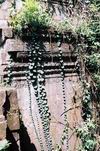 |
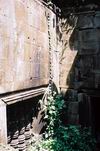 |
 |
 |
At the other end of the gallery there was a small opening to the outside world. But here untouched in the jungle of Cambodia was a frozen fragment of time. The silence became thick and the slightest sound from outside the gallery could be heard echoing through the long dark chamber. The light began to play tricks on me. The shadows from the leaves began to dance all over the walls. For an instance it was as if a projection of the ancient past was momentarily displayed on the walls. The light coming from the exit would grow dimmer when the clouds covered the sun high above the canopy of the temple. It was like being in a submarine looking out into a vast sea of green. The exit became a porthole into a strange world of fallen stones full of images of a culture that thrived on preserving all that had been learned thousands of years before from ancient India.
Then I felt a presence in this entombed fantasmagorical gallery. The deep melodious calls of the birds could be heard above the walls. All became a strange fantasy of a mixture of sounds, shadows, and my thoughts.
Why did the Prince come here today? Certainly he could travel to a much more manicured temple which I am sure he was more accustomed to. Why had all the children gone to the temple today to see the Prince pay his respects to the Buddhists monks?
It would not be possible for the Prince to find his way to the gallery I was in. It's far to dangerous, and there is no walking path that could get anyone here in the first place. This gallery is only accessible by climbing over countless piles of fallen stones and preferably with the help of a guide.
So, as I slowly made my way to the end of the gallery the shadow that I just saw moments before made me stop and stand transfixed. The interplay of light and shadow had created the image of a face, and in a most unusual way I felt I was being greeted. I decided to take out my camera and set it to flash. I had no idea if I would ever capture a shadow on film. But I did!
At the end of the gallery I could see the faint image of what looked like a human face. I wondered if it was just a shadow or if it was the spirit made manifest in a fleeting moment. Logic and reason surely could explain away any super natural presence. But the Neak Ta were here it was evident to me. Those ancestor spirits were ever so present at Beng Mealea and perhaps thats why the Prince made his way to Beng Mealea that day as well.
The modern world's encroachment on the solitude of the temples buried in the Cambodian jungles has a way of erasing any presence of the spirits that could still be resident within the sequestered chambers beneath the draped vines and tentacles of the trees. Beng Mealea has been locked away in time and is a perfect haven for spirits that do not want to be disturbed. According to Ang Choulean, director of Culture and Monuments of Apsara Authority in Phnom Penh, the Neak Ta is the most omnipresent figure of the divinities which populate the supernatural world of the Cambodian countryside. The essence of the Neak Ta, as an ancestor spirit, is inextricably bound to the soil. These Neak Ta are associated with ancestors and can be represented as figures or even as an amorphous objects such as a stone or even a termite mound. As an animistic belief the Neak Ta according to Chyoulean,
"is not just a kind of simple spirit but rather a phenomenon or energy force relating to a specific group such as a village community".
The Beng Mealea community, I am convinced, is host to this powerful energy force, and the Prince knows that as well.
The mythology of the Khmers is associated with ancient Brahmanism where an Indian King was the husband of Dharani; the goddess of the earth. Choulean's conclusion is that the concept of the linga and the yoni is close to the animistic beliefs of the early Khmers thus making a natural sysnthesis for Brahmanism and the Neak Ta and its correspondence to Shivaism. For Choulean it was easy for him to understand why the Shiavite ideology has dominated ancient Cambodia especially in the formation of the Devaraja cult. Spiritual forces and the spirit world are very much a part of animistic beliefs. The whole basis of animism is that the spirit world is stronger than humans. The power of the spirit lies within all things. In Cambodia today, a great number of village people still pay respect to the Neak Ta, and even though Kingship, Buddhism, and the communist ideology of Pol Pot dominated Cambodia in moments of time, the spirit world still is the predominant force of Cambodia.An example of present day animism in Cambodia was evident when a meteorite fell on Cambodian soil. A meteorite crashed into the remote Thmor Pouk district of Banteay Meanchey Province in Cambodia on monday morning January 24, 2005, and the local village took it as a sign of bad luck. The villagers wanted to turn the meteorite into a shrine to appease the Tsunami spirits that killed over 300,000 people December 26,2004 thinking it was their turn next to encounter disaster. The word meteroite translates into the Khmer language as "excrement of the stars", but some villagers think it is the tail of the Tsunami hitting them.
Rationalism categorically denounces any validity to animism. Thus, the consumer mentality, with its concommitant profit motive, attempts to create commercial tourist attractions around these ancient temples which will absolutely prevent any opportunity to experience an atmosphere of perfect stillness. With noise pollution the spirit world will be forever locked under the stones of Beng Meala, and a rare opportunity to perhaps communicate with the spirit world will be lost. This I know is an unacceptable way of thinking for the profit motive class of people. Nouth Narang, a member of the National Assembly in Phnom Penh, and an out spoken person to preserve the heritage of ancient Khmer traditions made this comment at an international conference on social justice in Ayuthaya, Thailand in May of 2000.
"Economic growth is only one of the means to achieve real human developmemt which also requires political, social and cultural emancipation as well as spirituality. To allow such harmony and more equity, more place must be given to spirituality...".
This faliure to recognize indigenous knowledge is an issue that Jannie Lasimbang of the Asia Indigenous Peoples Pact Foundation is trying to discuss with South East Asian states. Globilization, and the adverse effects of urban sprawl are creating a host of new problems preventing the preservation of ethnic identities. Indigenous knowledge is very different from the hi-tech social set which is roaming the planet acting as if the whole earth were a game board. Respect for worlds far different from the modern world's interpretation of reality, which is based in large part on consumerism, is going to pose a great challenge for global entrepreneurs to accept a shrine to a space oject as not being foolish, and that voices may be heard from the subtle movements of butterfly wings fluttering among the dense jungle vines. As a result of this encroaching "global consumer cult" the indigenous people of Cambodia have organized themselfs, and on September 12, 2004 made a statement in Trang Village, Chh'en Commune, Oral District, Kompong Speu Province which states,
"We, the representatives of indigenous communities from 14 provinces in Cambodia, gathered together in Trang Village for a National Forum on indigenous people and land. Our communities are generally defined by a common belief in a Village Neak Ta or Arak. Ceremonies to these Neak Ta or Arak are generally performed on an annual basis with many variations and similarities between indigenous groups. The new structures imposed from the outside have been eroding the role of traditional structures and systems and this is of great concern to our communities."But focusing on the heritage Beng mealea has left us we can ask what divinities have managed to survive the encroaching roots of trees embracing these temple walls? How many statues of Shiva are buried under the central tower or under the sea of vines? The sandstone carvings have all but eroded away, but with very close inspection it is possible to bring to life those special moments of dance and prayer which took place at Beng Mealea. Uncovering these rare masterpieces of ancient craftsmanship is a joy I can not fully explain. But as it is absolutly necessary to be perfectly still to feel and perhaps see the Neak Ta, so too do you have to look ever so closely through the vines, moss covered temple walls, and stones in order to see the adoring images honoring the gods of Shiva and Vishnu which were worshiped so long ago.
 |
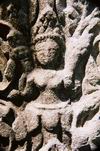 |
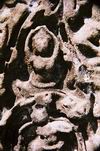 |
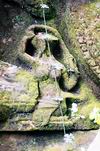 |  |
 Section 1: King Suryavarman II
Section 1: King Suryavarman II
 Section 2: Royal Welcome - Photo Gallery
Section 2: Royal Welcome - Photo Gallery
 Section 3: Muchalinda and the Neak Ta - Part 1.
Section 3: Muchalinda and the Neak Ta - Part 1.
 Section 4: Landmines and Apsaras
Section 4: Landmines and Apsaras
 Section 5: Hidden Treasures and Ancient Memories
Section 5: Hidden Treasures and Ancient Memories
Other stories related to the Khmer Empire.
 |
| 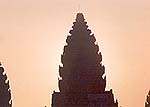 |
| 
Part I- Stones in the Sky - Before the Journey to Angkor Wat
Part II - Stones in the Sky - Journey to Angkor Wat - July 2002.
Part III - Stones in the Sky - Section I - Journey to Angkor Wat - March 2003.
Part III - Stones in the Sky - Section II - Journey to Angkor Wat - March 2003.
Part IV - Stones in the Sky - Journey to Preah Vihear - May 2004.
Apsaras and Devatas - Photo documentation of female divinities at Angkor Wat.